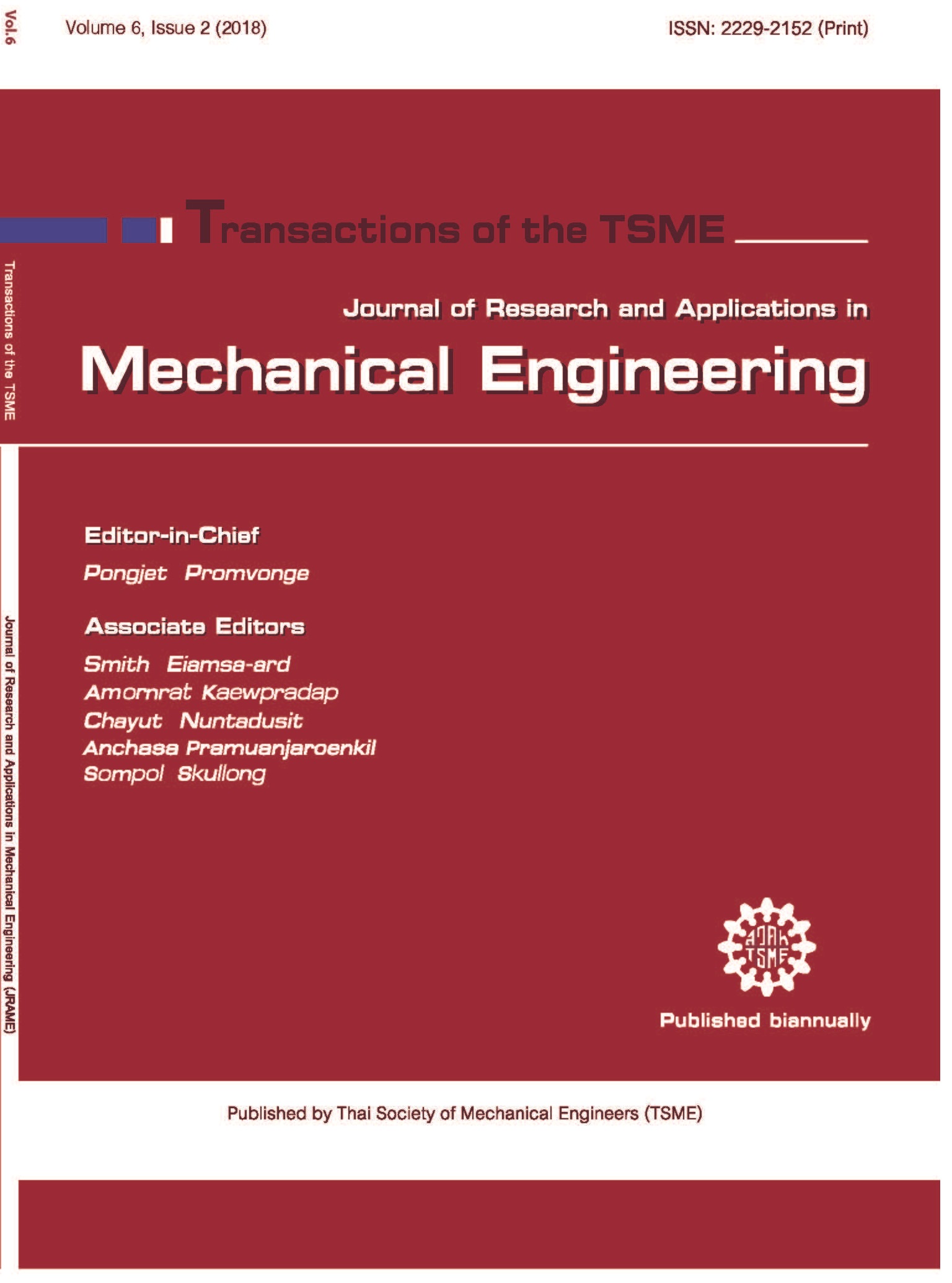The The effect of static and dynamic loading on femoral bone using finite element analysis
Main Article Content
Abstract
In using finite element analysis on bone-implant models, the static loading condition is the peak load of dynamic loading condition under daily activities. Dynamic loading will affect the strain distribution on the bone and stress distribution on the implant. In this research, the normal bone, bone inserted with load-bearing device and bone inserted with load-sharing device under static and dynamic loading conditions were analyzed to compare the stress distribution on the implant and strain distribution on the bone. The results show that the maximum difference of equivalent total strain between static loading condition and dynamic loading condition in normal bone is less than 20%, in bone inserted load-bearing device is less than 12%, and in bone inserted load-bearing device is less than 30%. The maximum difference of von Mises stress between static loading condition and dynamic loading condition in load-bearing device is less than 3% but exceeds 105% for load-sharing device. The static loading and dynamic loading conditions can be used interchangeably in analyzing normal bone and load-bearing devices while dynamic loading condition is considered more suitable for load-sharing devices in finite element analysis of bone-implant models.
Article Details
This work is licensed under a Creative Commons Attribution-NonCommercial-ShareAlike 4.0 International License.
References
[2] Aroonjarattham, P., Aroonjarattham K. and Chanasakulniyom, M. Biomechanical effect of filled biomaterials on distal Thai femur by finite element analysis, J. Kasetsart (Nat. Sci.)., Vol. 49(2), 2015, pp. 263-276.
[3] Somtua, C., Aroonjarattham, P. and Aroonjarattham, K. The comparison of strain distribution on Thai normal, varus and total knee arthroplasty inserted femoral bone, Journal of Research and Applications in Mechanical Engineering, Vol. 2(1), 2014, pp. 42-50.
[4] Aroonjarattham, P., Aroonjarattham, K. and Somtua, C. The notch effect on strain distribution on Thai femoral bone after total knee arthroplasty, Journal of Research and Applications in Mechanical Engineering, Vol. 2(1), 2014, pp. 51-56.
[5] Heller, M.O., Bergman, G., Kassi, J.P., Claes, L., Hass, N.P. and Duda, G.N. Determination of muscle loading at the hip joint for use in pre-clinical testing, Journal of Biomechanics, Vol. 38(5), 2005, pp. 1155-1163.
[6] Gautier, E., Perren, S.M. and Ganz, R. Principle of internal fixation, Curr Orthop., Vol. 6(4), 1992, pp. 220-232.
[7] Bottner, F., Zawadsky, M., Su, E.P., Bostrom, M., Palm, L., Ryd, L., et al. Implant migration after early weightbearing in cementless hip replacement, Clin Orthop Relat Res., Vol. 436, 2005, pp. 132-137.
[8] Thomas, H.M., Adolph, V.L., Joseph, R.L., Hiroshi, F., Jodi, F.H., Suan, G.C., et al. Minimal 10-year results of a tapered cementless femoral component in total hip arthroplasty, J. Arthroplasty., Vol. 16(8 Suppl 1), 2001, pp. 49-54.
[9] Zalzal, P., Cheung, G., Bhandari, M., Spelt, J.K. and Papini, M. The load sharing characteristics and stress concentrations of a locked, retrograde, intramedullary femoral nail, Orthopaedic Proceeding, Vol. 90-B (supp I), 2008, pp. 71.
[10] Dowdy, P.A., Rorabeck, C.H. and Bourne, R.B. Uncemented total hip arthroplasty in patients 50 years of age or younger, J. Arthroplasty., Vol. 12(8), 1997, pp. 853-862.
[11] Mallory, T.H., Head, W.C. and Lombardi, A.V. Tapered design for the cementless total hip arthroplasty femoral component, Clin Orthop Relat Res., Vol. 344, 1997, pp. 172-178.
[12] Hellman, E.J., Capello, W.N. and Feinberg, J.R. Omnifit cementless total hip arthroplasty: a 10-year average follow-up, Clin Orthop Relat Res., Vol. 364, 1999, pp.164-174.
[13] Head, W.C., Mallory, T.H. and Emerson Jr, R.H. The proximal porous coating alternative for primary total hip arthroplasty, Orthopedics, Vol. 22(9), 1999, pp. 813-815.
[14] Stephenson, P. and Seedhom, B.B. Cross-section geometry of the human femur in the mid-third region., Proc Inst Mech Eng H., Vol. 213(2), 1999, pp. 159-66.
[15] Zalzal, P., Backstein, D., Gross, A.E. and Papini, M. Notching of the anterior femoral cortex during total knee arthroplasty, J. Arthroplasty., Vol. 21(5), 2006, pp. 737-743.
[16] Bregmann, G. HIP98, 2001, Free University, Berlin.
[17] Senalpati, S.K. and Pal, S. Uhmwpe-alumina ceramic composite, an improved prosthesis material for an artificial cement hip joint, Trends Biomater Artif Organs., Vol. 16, 2002, pp. 5-7.
[18] Peraz, C., Mahar, A., Negus, C., Newton, P. and Impelluso, T. A computational evaluation of the effect of intramedullary nail material properties on the stabilization of simulated femoral shaft fracture, Med Eng Phys., Vol.30(6), 2007, pp. 755-760.
[19] Ramos, A. and Simoes, J.A. Tetrahedral versus hexahedral finite elements in numerical modeling of the proximal femur, Med Eng Phy., Vol. 28, 2006, pp. 916-924.
[20] Frost, H.M. Wolff’s law and bone’s structural adaptation to mechanical usage: an overview for clinicians, The Angle Orthodontist, Vol. 64(3), 1994, pp. 175-188.
[21] Frost, H.M. Update of bone physiology and wolff’s law for clinicians, Angle Orthodontist, Vol. 74, 2003, pp. 3-15.
[22] Black, J. and Hastings. G. Handbook of biomaterials properties, 1998, Chapman & Hall, UK.


